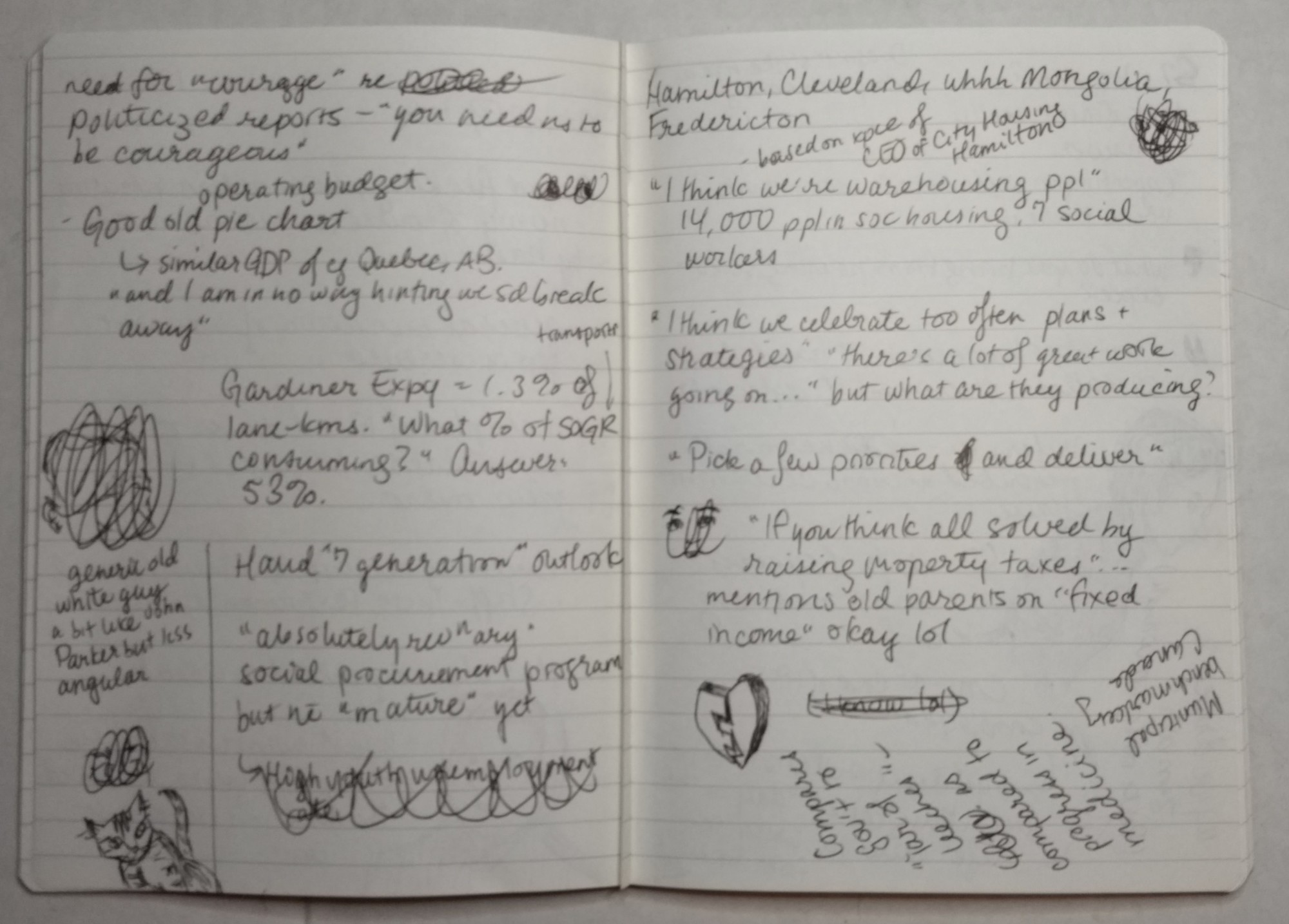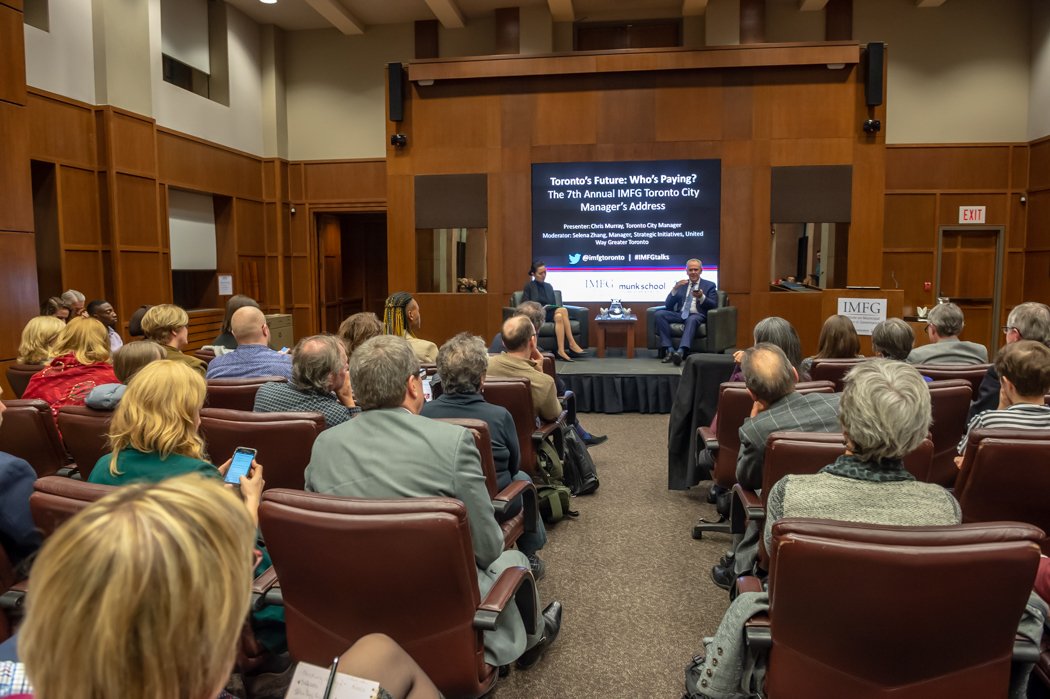Photo from @imfgtoronto.
“The iceberg is gone, global warming has taken care of that,” jokes new City Manager Chris Murray as he begins his speech.
The iceberg, a municipal budget infographic portraying the City of Toronto’s billions of dollars in approved but unfunded capital projects, had become a cult favourite among City Hall wonks—you know, the kind of people who have cult favourite municipal budget infographics. These are the kind of people who go to the IMFG‘s annual City Manager’s Address, which took place at the end of November. (Slides available here.)
Okay, so, if you look at municipal government as a corporation1, the City Manager is basically the CEO. Along with the Deputy City Managers and Chief Financial Officer, they do the day-to-day work of running the massive organization that is the civil service—not just the public-facing workforce for City services and facilities like daycares and parks, but all the internal structure like the HR and IT departments, plus the City’s real estate and other assets. City Council sets the budget and policy directions, and the City Manager and all the people who answer to him decide exactly how to get it done.
Any Toronto City Manager must walk a fine line between telling Council that Things Cost Money, and carrying out Council’s instructions to Less Money More Things Let’s Build a Subway Wait What? It’s a job with a relatively high turnover rate, as Murray himself admits. Longtime civil servant Joe Pennachetti became City Manager in 2002 under Mel Lastman and retired in 2015, not long after the turbulent Rob Ford years. His successor, former provincial bureaucrat Peter Wallace, left for the Treasury after three years. Both wisely saved the brutal honesty till later in the game: Pennachetti, who eventually told Rob Ford there was no more gravy, brought up new revenue tools on his way out. Wallace’s frank financial advice was watered down before it (belatedly) got to City Council. Bureaucrats have to be politic. But the City Manager’s Address is a chance to get a better idea of how they see things, albeit in PowerPoint format.
There is, indeed, no iceberg. Murray’s first presentation is less a dry financial overview than an introduction to where he comes from and how he approaches things. He hails from Fredericton, NB, and served as Hamilton City Manager before being tapped for this post. In person Murray’s affable, maybe even folksy. He posts pictures of his kids, talks about his elderly parents. Every now and then, he likes to accompany front-line workers as they go about their day, to get a feel for what it’s like (“I’ve driven a zamboni”).
Before he was Hamilton’s City Manager, Murray headed the city’s social housing agency; he speaks frankly about the results of neglecting “so-called ‘soft-services'” (“I think we’re warehousing people”), and criticizes plans and strategies that are triumphantly unveiled and then never followed up on. (This is a common Toronto failing.) He’s big on things like outcomes and deliverables and benchmarks, unconcerned with “legacy” (“there’s a few of us who weren’t built that way”).
That said, I come away with the impression that he intends to carry on with the status quo politics of City Hall. Speaking of revenue, he says, you can’t solve everything by raising property taxes, there are people like my parents on fixed incomes. (Property taxes are Toronto’s chief revenue source and have been essentially flatlined for years. Also, Toronto has tax relief programs for low-income seniors and disabled people.) Where to get the revenue? He says something about the private sector. He’s optimistic about using Section 37 for housing. And, a bit disappointing for a talk themed “Toronto’s Future”, he doesn’t seem especially tech-savvy when it comes to issues like data privacy.
Anyway, here’s where I read way too much into things. He mentions he doesn’t really know what’s under a smartphone screen; he likes Apple because you take it out of the box and it just works. Relatable, right? Well, not if you’re me, the sort of person who, in the words of Parker Higgins, has been asked to stop talking about free software before. Apple devices are sleek and beautiful because they’re not designed to be opened up by anyone but an Apple technician with a special plastic “spudger” or, nowadays, proprietary diagnostic software.
For many, this is a feature, not a bug. And this jibes with another of Murray’s offhanded remarks, about contracting out services; detractors say you give up control, he says, but he doesn’t see the issue. Hey, maybe you, reader, agree. It’s a valid opinion. But personally, it worries me a little, because I see this as one of the driving trends in our municipal government: increasingly relying on non-profits, philanthropists, and big corporations to not just fund but run our city.
It’s a bit like Uber, you know? You let some third party take shit over, and by the time they start implementing things you don’t like, it’s out of your hands. But that’s really only a problem for the people who depend on that thing. And those people aren’t the politicians. Or the bureaucrats.
Anyway, good talk!
High points: moderator Selena Zhang gives a shout-out to the Facebook group NUMTOT; Murray drops the surprising fact that the Gardiner Expressway comprises 1.3% of Toronto’s road-kilometres but takes up 53% of the capital repair budget.
P. S. Neither my phone nor my Bluetooth keyboard were co-operating, so I was writing notes by hand. In case anyone’s curious:

- I mean, it’s literally a corporation. ↩

One thought on “Recap: The 2018 City Manager’s Address”